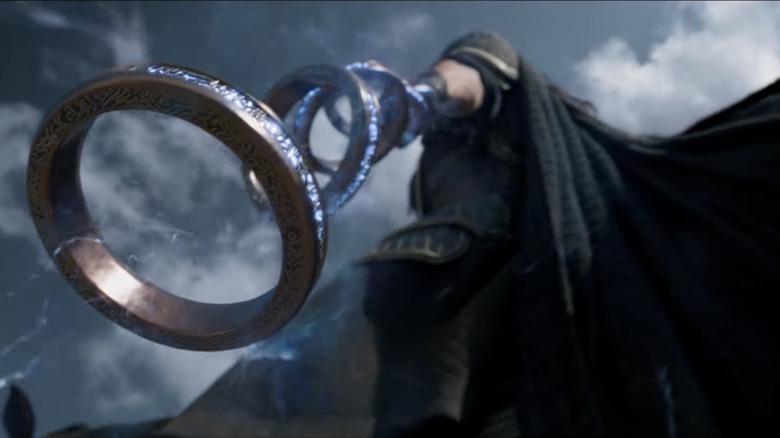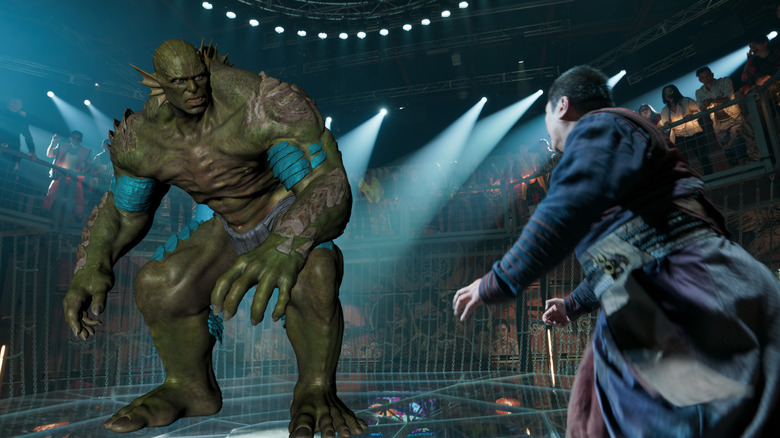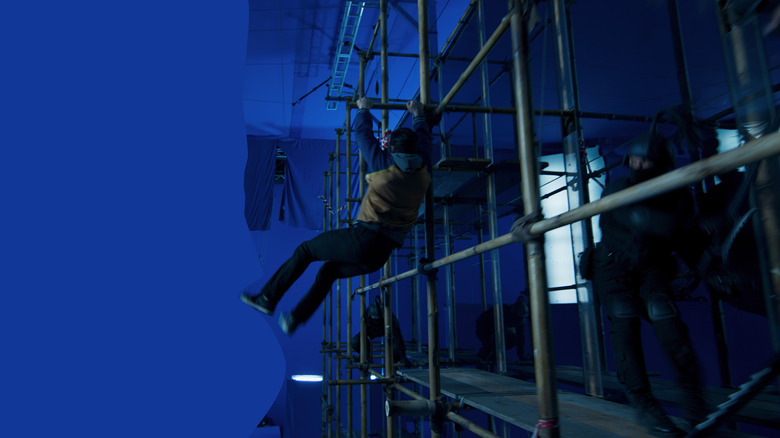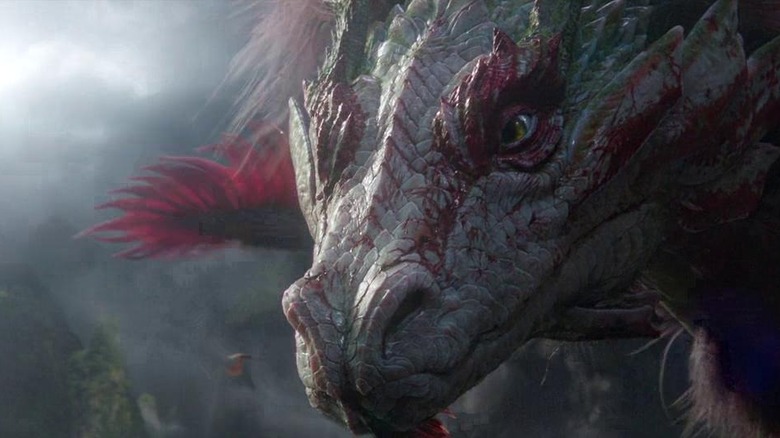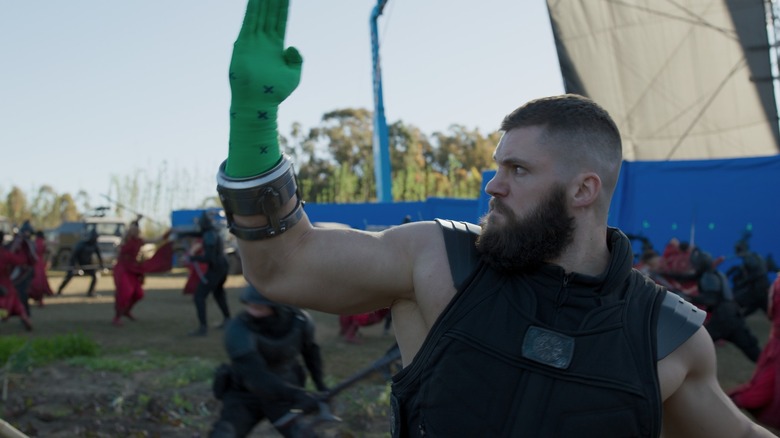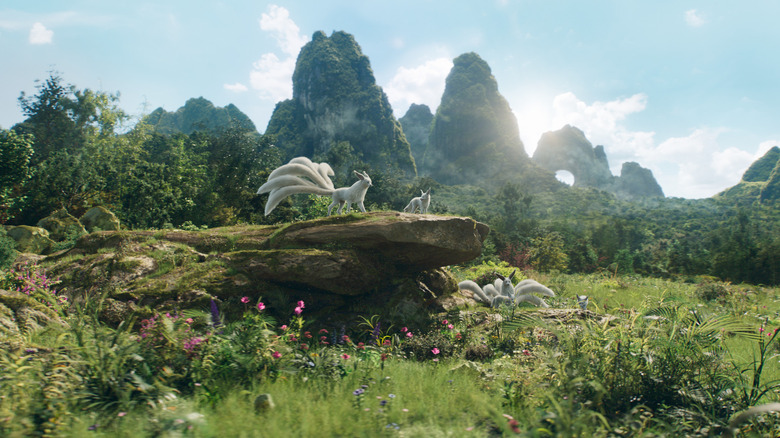Shang-Chi VFX Team On Animating Dragons And Why Movies Aren't As Colorful Anymore [Interview]
"Shang-Chi and the Legend of the Ten Rings" almost feels like several movies smashed into one, a statement that reflects the complicated comic book history of the character just as much as it accurately portrays the sheer scope and scale of the visual effects on display. At any given point in the film, viewers can expect to see sweeping battlefield vistas in the epic prologue that kicks off the action, a breathtaking scaffold fight that just might stand out as one of Marvel's most effective and dynamic hand-to-hand fight sequences, fantastical creatures spanning from dragons to, well, the one and only Morris, and the stunning effects of the legendary Rings themselves.
If audiences felt like they had to stay on their toes throughout the action, then that's nothing compared to what the visual effects (VFX) crew experienced throughout production on the ambitious title. Marvel required the service of dozens of visual effects vendors to do their individual parts and breathe life into the sprawling set pieces, otherworldly locales, extensive power sets, and so much more. Luckily, I was able to wrangle together a number of the most prominent VFX and SFX (special effects) artists who contributed to all sorts of elements on "Shang-Chi" and pick their brains about their perspectives on all the behind-the-scenes happenings that us viewers are rarely privy to.
In the following interview, I was joined by VFX Supervisor Christopher Townsend ("Guardians of the Galaxy Vol. 2," "Avengers: Age of Ultron," "Pirates of the Caribbean: Dead Man's Chest," "The Lost World: Jurassic Park"), Additional VFX Supervisor Joe Farrell ("The Jungle Book," "Anomalisa," "The Wolf of Wall Street," "Star Trek," "Speed Racer"), VFX Supervisor Sean Walker ("Avengers: Endgame," "Independence Day: Resurgence," "The Hobbit" trilogy, "Dawn of the Planet of the Apes") of WETA Digital, and SFX Supervisor Dan Oliver ("Thor: Love and Thunder," "The Invisible Man," "Mad Max: Fury Road," "The Matrix Reloaded") to talk about bringing their wealth of experience to the table, juggling all the various demands in "Shang-Chi," and even getting to the bottom of whether blockbusters these days are duller and less colorful than they used to be.
"Marvel Has Changed the Game a Little Bit"
I hate to start this off by reminding you guys how long you've been doing this, but that's exactly what I'm going to do [laughs]. So obviously all of you guys have been in this industry for decades now. Do you feel like you needed all those years of experience to do a movie with as many moving parts as this one?
Christopher Townsend: Yeah. I think one of the great things about working in these films, and particularly MCU, is how varied each film is. They all stand on their own, but they also work in tandem with all the other films and obviously within the MCU. And I think it's very exciting. So I think each film brings its own challenges and obviously the more we do this, the more experience we have and the history we have that we can bring into the filmmaking. But I think each one's new. I mean, that's what makes it all so exciting.
Joe Farrell: Yeah, for sure. I would second that and just say, you can never have enough experience leading up to these things, because there's always problems that come up that you don't know how to answer, but the beauty of this is, it was such a collaborative experience, especially with Destin {Daniel Cretton], the director, always wanting to hear your input and experience and just trying to problem solve. So even if you didn't really necessarily know the answer there, we were all going to find the answer during the process. And of course it was a fairly long shoot, about nine months with a three month break due to the pandemic. So it was a taxing one, but definitely quite collaborative and all your experience certainly gets pushed towards limits [laughs].
Dan Oliver: I would agree with Joe and what he touched on there is, your experience gives you the confidence to know that when problems come up. You don't necessarily have the answer straight away, but you have the confidence to know that you can work it out. That's what I find. That's what works for me. Just knowing that, having the confidence that you will work it out.
Sean Walker: From a vendor side, having as much experience as possible is what helps you to solve all those problems. Marvel has changed the game a little bit in regards to visual effects because it's a lot more of an organic process than we have traditionally been used to. So making sure that you are flexible in your techniques and your workflows, make sure that you are able to develop along with the story. That's the biggest thing that I've found over the years, especially working with Marvel, is to make sure that you are able to problem solve, really [laughs]. That's what it all comes down to.
"An Awful Lot of Sequences and an Awful Lot of Different Sorts of Effects"
Chris and Dan, how much did your past collaborations with each other factor into "Shang-Chi"? Did you have a shared language already? Does it make the process a little smoother for you two?
Townsend: I think going back to the idea of experience and you go into this and you can look at Dan's body of work and he's incredibly experienced and you know you can rely on him. So there's an automatic shared language there, just sort of understanding between the two of us and between everyone on the team that you lean into that experience and the wealth of that knowledge and just, you have confidence that the other side of the coin is going to be able to solve of problems that you can't or whatever. It's very useful.
Oliver: Yeah, agreed. Experience gives you the ability to talk the same language and you trust each other and that just makes it more easy that you're in the shoot. Definitely.
Townsend: I think it's interesting. I will go into these films and at the very beginning, there are many things that I have absolutely no idea how we're going to achieve. And it's not like you go, "Oh yeah, I've done that before." There's always something new and exciting. And so I'm like, "Okay, I'm an open book and I'm going to try and figure this out and learn alongside my colleagues and the rest of the team. And that's what I think keeps it all so fresh.
Specifically on "Shang-Chi," even more than the average Marvel movie, it seems like it's constantly throwing new things at viewers, VFX-wise. After the prologue, the first act is mostly naturalistic and then you hit the bus scene and then after that you have the underground fight club, then you have the scaffolding fight. Did you guys get that experience while working on it? Were you always working on something new, every single day? How did that work on your guys' end?
Townsend: I think we tried to break the sequences up. You would concentrate, obviously when you're shooting, you're spending several days shooting one thing and then you move on to something else. And yeah, it was always a brand new thing to be trying to figure out. But I think that between the overall supervising challenges, Joe took on a couple of the main sequences at the beginning with the bus fight and the Macau scaffolding fight. And he oversaw a lot of the day-to-day work there, which allowed me you to free up to do other stuff and the other sequences throughout the film. So I think that you try and delegate and pass out the tasks at hand. Dan's team was a pretty substantial team, the special effects team working on many different things throughout. And then Sean was obviously... WETA was responsible for a lot of the third act stuff. So you try and figure out who can do what to keep things moving along, but you're right. You've got an awful lot of sequences and an awful lot of different sorts of effects all on the boil at the same time. It's a fun challenge [laughs]. Keeps you busy.
"Just as You Would Cast an Actor, You Try and Cast Visual Effects Companies"
Jumping off of that, all these different vendors are doing all these different things at the same time. From your perspective, how difficult is that? And does that get easier with each project that you do?
Townsend: I think that it's, you try and cast... just as you would cast an actor, you try and cast visual effects companies to do the work so that you go to hopefully the best people in the business to get certain things done, whether it's environments or creatures or big spectacle, or the simulation effects, all this kind of stuff, and you cast that as carefully as possible. And then you rely on those teams and Sean, you rely on the team and the leadership of those individual teams to get those sequences completed.
Walker: Yeah, it's interesting. We've collaborated with a lot of other vendors as well, throughout the years and it's almost always a bit of a new challenge anyway. While everyone is working on their new films, they're obviously always pushing their own technologies. So basically when we start to share assets or share environments or creatures, we've all been moving up in our own different ways. And so when we do start to share things again, it's a little bit of an exploration. Every vendor on these shows are extremely helpful. We'll get together every once in a while if we're coming up with problems and it's an extremely collaborative process between us all. It can be a challenge for certain things, but for the most part it's all very easily solvable.
Which sequences did you guys handle from your end?
Walker: For us, we handled almost everything for the third act battle. So basically when Shang-Chi gets punched into the water, from then on.
And with something as specific as the dragon sequence, what do you use as a frame of reference for that? How do you animate that?
Walker: [Laughs] We look at a whole lot of real-life reference. So for the Great Protector dragon, as far as animation goes and movement, we looked at... because it was a wingless dragon, we wanted to make sure that it still had a base in reality. So we made it feel like it was swimming through the air and reference for that were things like sea snakes and underwater iguanas as they're pushing... and we found that they kept a very steady, focused head and the rest of their body helped propel their motions through the water. And we leaned into that quite a bit for the Great Protector.
"We Had to Rely on our Actors Performing as Much as Possible"
From each of your perspectives, what was the most difficult shot, sequence, or stunt from your point of view that audiences might not necessarily have thought was all that difficult?
Townsend: There are so many things [laughs] in the film that are obviously incredibly challenging. I think overall, we wanted this film... because it was obviously a very heavy martial arts film. And we wanted to play homage to Asian cinema, particularly Hong Kong and Chinese cinema and the way that those films are made. And so what that meant was long takes and camera moves that were keeping on our actors as much as possible and seeing our actors doing these actual stunts themselves. That meant we had to rely on our actors performing as much as possible. But also on those shots where we couldn't because the moves were just too complex, the takes were too long, or it was too dangerous, we would rely on a lot of stunt performers. So there's an awful lot of face replacements that are going on in the film, which hopefully the audience doesn't notice. One of the other big challenges is shooting outside when you are reliant on the weather and the whole third act, when we're in this mystical place called Ta Lo. Throughout the film, the lighting is supposed to be changing, getting darker and more and more moody. And in fact, we shot it in harsh Sydney, Australia sunlight. And so that was a real challenge to try and keep that story point and that narrative continuing and to make it look real, as if the storm clouds were coming and things were getting a little bit more ominous. So I think those two things particularly were challenging from my point of view.
Farrell: Certainly one of the challenges with the bus sequence was being able to pull the three different units together into one cohesive piece. It was shot in, I think, three different countries. It was shot in America, here in Los Angeles and in San Francisco. We shot in Sydney, obviously. That's only two countries [laughs]. But certainly the challenge was trying to figure out how to gel all that together and make it believable, was certainly a challenge from that point of view. And as Chris mentioned, we shot in... parts of the third act in Sydney was with these huge big shade cloths and trying to fit our performers into these enormous covers to be able to pull off that third act, was certainly something that people probably didn't really notice. But it was certainly a challenge to try and make that work.
"Those Films With More Subdued or Homogenous Color Palettes are Generally Easier to Pull Off"
There's a big discussion point on social media among movie fans about how movies these days, especially blockbusters, they're not as bright, as vibrant as they used to be. Perhaps with a slightly more desaturated color palette, that makes the visual effects a little easier to integrate. Do you guys buy into that at all?
Townsend: I think "Shang-Chi" had vibrancy throughout, but certainly a more muted subdued color palette is absolutely helpful to make things feel more real. When you... take it all the way to the extreme into a black and white movie. A black visual effect, in black and white to make them feel like they're part of the photographic image, is generally easier because you're taking out the whole component of color and vibrancy. And I think that generally is an easier thing to do. And so those films with more subdued or a more sort of homogenous color palette are generally easier to pull off. But I do think a lot of the MCU stuff and particularly "Shang-Chi," it had some vibrancy and we wanted to keep that. We wanted to keep that world of Ta Lo vibrant and lush. It makes it much harder to pull that stuff off, but that was part of the narrative and part of the storytelling, that it's supposed to feel that way. So that was an important aspect that we wanted to maintain.
Farrell: Certainly the Macau sequence in particular had those giant big colorful billboards where we had huge swaths of color and really, really bright lights. So it was certainly something that we actually strived for which is more of a graphic nature of those shots. Especially when there's the Death Dealer fight at the end there in front of the giant pink billboard, where we distinctly went out of our way to really hold onto that color and that incredible vibrancy that we could get from both the main photography and, of course, what we were adding to it.
